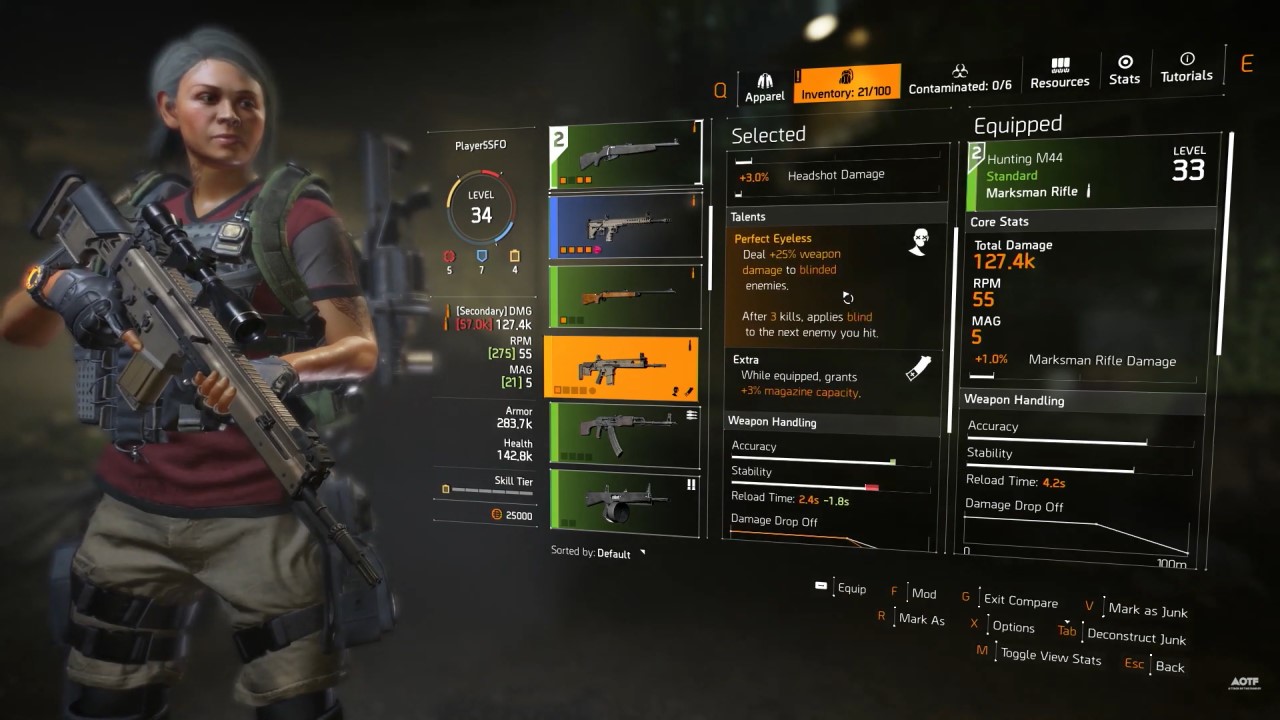The Division 2: Warlords of New York will launch with the much anticipated Gear 2.0 overhaul, which will make creating effective builds easier than ever. The new system brings a host of much needed refinements, paired with a cleaner UI that will better assist agents with parsing what drops are improvements and which are trash. Moving from the old Gear 1.0 to 2.0 may seem daunting at first, but this guide will set agents up for success.
Every item in The Division 2 will make the transition to Gear 2.0 in Title Update 8, from your preferred Gear Sets to your darling exotics. No item will be spared, even if you didn’t buy Warlords of New York, so it’s best to understand what the changes are.
Gear 2.0 completely revises Talents and Attributes
All talents are being removed from regular High End and Superior items, with the exception of chest pieces, backpacks and weapons (a list of these new gear talents can be found here). These will reroll with one of the new talents making their debut in Gear 2.0.
Exotics will have revised talents, and Named Armor will have their talents replaced either with a roll higher than what is normally permitted, or with a roll not usually found on that specific category of equipment. Gear Sets will have a backpack and chestpiece talent as well, but they will be designed to amplify and enhance the four-piece set bonus. A list of the new exotics and their drop locations can be found here.
Wait, a stat roll that doesn’t normally appear? Yep, stats in Gear 2.0 do not roll on as wide a range of equipment as they once did, allowing each type of item more room to specialize. This goes doubly for Brand Sets, which have all been updated to feature set bonuses that compliment a specific playstyle (and a list of those bonuses is located here).
A large part of this stat overhaul comes from the newly introduced Core Attributes (which function similarly to the core attributes from the first game). All gear will now roll with one of three core attributes outside the regular attributes: Weapon Damage, Armor, or Skill Tier (which replaces Skill Power).
Attributes will roll based on the core attribute on an item, so while it’s not impossible to find a red weapon roll on a yellow Skill Tier item the majority of gear will feature attributes that better compliment one another. Brand Sets will have a core attribute assigned to them based on the role they fill, so defensive brands will have Armor, damage brands will have Weapon Damage, and skill brands will have Skill Tier.
This also means talents no longer require a set amount of specific skills to unlock, so agents can focus on the stats they want without worrying about whether their talents will activate or not.
The Budget System has been tossed out, so stat rolls no longer limit each other. All stats now have a chance to roll well, no matter how great other stats on an item are.
Damage to Elites and Explosive Damage have been removed from the loot pool, and will be replaced with a stat that fits their old role (so a damage roll for DTE, and skill roll for Explosive Damage). Explosive Damage does appear on two Brand Sets, it will merely not roll on other items with Gear 2.0.
The attributes that can roll on gear now are as follows:
- Weapon Damage
- Skill Tier
- Armor
- Weapon Handling
- Critical Hit Chance
- Critical Hit Damage
- Headshot Damage
- Skill Damage
- Skill Repair
- Skill Haste
- Armor Regeneration
- Hazard Protection
- Health
- Explosive Resistance

Gear Mods and Skill Mods
Mods have also been updated in Gear 2.0, though they function much as they did before. Gear mod slots will only roll on specific pieces of gear – the mask, backpack and chest piece. There will only be one mod slot each, and gear mods have been condensed to a single roll.
With the removal of Skill Power for Skill Tiers, skill mods no longer have a limitation associated with their use. Any skill mod can be equipped, regardless of Skill Tier. This means Battery Mods have been removed. These will remain a single roll.
Weapons
Weapons will now roll with two core stats: damage for their class, and their special bonus (Crit Chance for SMGs, for example). A third stat can roll on High-End weapons that wouldn’t normally roll on that class of weapon, such as increased health damage on a shotgun. An active talent will still appear on High-End and Superior weapons, and they are listed here.
Updated UI ties it all together
To make all these changes easier to parse the UI has received an overhaul. All stats on all items will have a bar beneath them that will indicate how well that stat rolled within its allocated range. A bar filled almost entirely to the right has a better roll than a bar hovering closer to the left. A perfect roll, or “God Roll”, will have a filled out bar, and will be highlighted in orange. An orange icon will also be visible on the item’s portrait to indicate a God Roll is present.
Gear mods and skill mods will also have this bar underneath their stats, so agents can tell at a glance if a mod is worth keeping or scrapping. Weapon stats are directly below the total damage, RPM, and magazine window, and also feature the range bar indicating how well that weapon’s damage and class bonus rolled.
This cleaner UI not only makes it easier to parse what gear is worth equipping, but what is worth saving for the Recalibration Library. Agents can now permanently store rolls in the Recalibration Library that can be used an unlimited amount of times. Whenever an item drops that has a roll better than one stored in the library the UI will display this with an icon next to that roll. Rolls can be overwritten in the library, so knowing when you have an upgrade worth storing is a boon.
Fewer drops, but more rewarding
Because these changes make drops more impactful than they were before, loot drops have been slightly reduced. The idea behind this alteration is simple: there is less trash to filter through, with each drop now being more meaningful and useful.
To facilitate this change to drop rates, difficulties have been tweaked to be more rewarding the higher you climb. A perfectly rolled item can appear in Story difficulty, but it will be rarer compared to loot dropped from Heroic. Essentially, the harder the difficulty the smaller the range becomes for stats to roll, increasing an agent’s chance to receive loot with multiple top-end stats, or God Rolls.
Due to this change in how difficulties award loot, Gear Score has been removed for players at level 40; all gear will drop at level 40, and it will be the number of quality rolls that distinguishes loot. The Division 2 agents that do not purchase Warlords of New York will continue to have Gear Score, and it will be boosted to 515. Gear Score 500 to 515 loot will work in a similar manner, however, with higher Gear Score items rolling better stats. Tackling harder content will increase the chances of seeing higher gear score loot drop.
To conclude…
Gear 2.0 affects every item in the The Division 2, whether you bought Warlords of New York or not. Regardless of it you are hunting the perfect level 40 loot, or grinding out that 515 Gear Score equipment, the updated system will be felt by everyone. These seismic changes to the loot mean you can safely sell or junk whatever items have been resting in your stash up until this point, seeing as everyone will be climbing a new power ladder.
That’s all there is to Gear 2.0. The Division 2 needed a proper polishing of its gear mechanics for a while now, and Gear 2.0 is precisely what the game needed. It may seem daunting at first, but given time agents will find the new system more flexible and rewarding than what came before.
For more The Division 2: Warlords of New York guides check out our guide hub.











Published: Mar 2, 2020 03:20 am